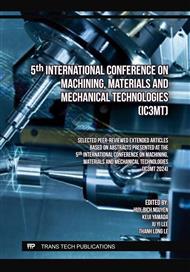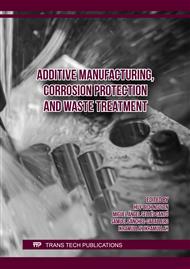[1]
Sen, M., & Shan, H. S. (2006). Analysis of roundness error and surface roughness in the electro jet drilling process. Materials and manufacturing processes, 21(1), 1-9.
DOI: 10.1081/amp-200060398
Google Scholar
[2]
Coteaţă, M., Schulze, H. P., & Slătineanu, L. (2011). Drilling of difficult-to-cut steel by electrochemical discharge machining. Materials and Manufacturing Processes, 26(12), 1466-1472.
DOI: 10.1080/10426914.2011.557286
Google Scholar
[3]
Thanigaivelan, R., & Arunachalam, R. M. (2010). Experimental study on the influence of tool electrode tip shape on electrochemical micromachining of 304 stainless steel. Materials and manufacturing processes, 25(10), 1181-1185.
DOI: 10.1080/10426914.2010.508806
Google Scholar
[4]
Malapati, M., & Bhattacharyya, B. (2011). Investigation into electrochemical micromachining process during micro-channel generation. Materials and Manufacturing Processes, 26(8), 1019-1027.
DOI: 10.1080/10426914.2010.525575
Google Scholar
[5]
Rajurkar, K. P., Levy, G., Malshe, A., Sundaram, M. M., McGeough, J., Hu, X., ... & DeSilva, A. (2006). Micro and nano machining by electro-physical and chemical processes. CIRP annals, 55(2), 643-666.
DOI: 10.1016/j.cirp.2006.10.002
Google Scholar
[6]
Öpöz, T. T., Ekmekci, B., & Erden, A. (2009). An experimental study on the geometry of microholes in microelectric discharge machining. Materials and Manufacturing Processes, 24(12), 1236-1241.
DOI: 10.1080/10426910903129422
Google Scholar
[7]
Ali, M. Y., Hamad, M. H., & Karim, A. I. (2009). Form characterization of microhole produced by microelectrical discharge drilling. Materials and Manufacturing Processes, 24(6), 683-687.
DOI: 10.1080/10426910902769343
Google Scholar
[8]
Bhattacharyya, B., Malapati, M., & Munda, J. (2005). Experimental study on electrochemical micromachining. Journal of Materials Processing Technology, 169(3), 485-492.
DOI: 10.1016/j.jmatprotec.2005.04.074
Google Scholar
[9]
Tsui H.P., Hung J.C., You, J.C., & Yan, B.H.(2008). Improvement of electrochemical micro-drilling accuracy using helical tool. Materials and Manufacturing Processes, 23(5),499-505.
DOI: 10.1080/10426910802104237
Google Scholar
[10]
Tsui, H. P., Hung, J. C., Wu, K. L., You, J. C., & Yan, B. H. (2011). Fabrication of a microtool in electrophoretic deposition for electrochemical microdrilling and in situ micropolishing. Materials and Manufacturing Processes, 26(5), 740-745.
DOI: 10.1080/10426910903536816
Google Scholar
[11]
Kurita, T., Chikamori, K., Kubota, S., & Hattori, M. (2006). A study of three-dimensional shape machining with an ECμM system. International Journal of Machine Tools and Manufacture, 46(12-13), 1311-1318.
DOI: 10.1016/j.ijmachtools.2005.10.013
Google Scholar
[12]
Chikamori, K. (1998). Possibilities of electrochemical micromachining. International Journal of the Japan Society for Precision Engineering, 32(1), 37-38.
Google Scholar
[13]
Hewidy, M. S., Ebeid, S. J., Rajurkar, K. P., & El-Safti, M. F. (2001). Electrochemical machining under orbital motion conditions. Journal of Materials Processing Technology, 109(3), 339-346.
DOI: 10.1016/s0924-0136(00)00827-x
Google Scholar
[14]
Fang, J., & Jin, Z. (2002). ECM polishing research of assistant magnetic field, Chin. Surf. Eng, 15(3), 24-26.
Google Scholar
[15]
Yan, B. H., Chang, G. W., Cheng, T. J., & Hsu, R. T. (2003). Electrolytic magnetic abrasive finishing. International Journal of Machine Tools and Manufacture, 43(13), 1355-1366.
DOI: 10.1016/s0890-6955(03)00151-2
Google Scholar
[16]
Cheng, C. P., Wu, K. L., Mai, C. C., Hsu, Y. S., & Yan, B. H. (2010). Magnetic field-assisted electrochemical discharge machining. Journal of Micromechanics and Microengineering, 20(7), 075019.
DOI: 10.1088/0960-1317/20/7/075019
Google Scholar
[17]
Zhang, C., Zheng, P., Liang, R., Yun, K., Jiang, X., & Yan, Z. (2020). Effects of a magnetic field on the machining accuracy for the electrochemical drilling of micro holes. International Journal of Electrochemical Science, 15(2), 1148-1159.
DOI: 10.20964/2020.02.10
Google Scholar



